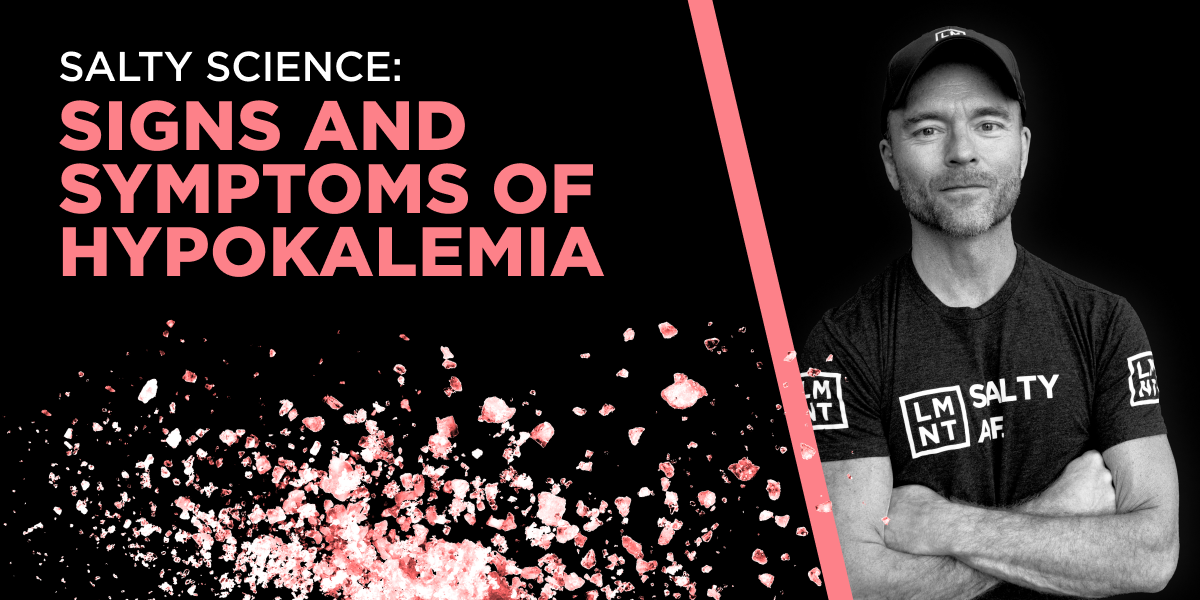Low blood potassium, aka hypokalemia, is much more serious than a dietary potassium deficiency. Eating a low-potassium diet, while not optimal, is not a severe enough trigger to short your blood on potassium.
That’s not to say that low-potassium diets aren’t an issue — it’s just that the human body maintains blood potassium levels at all costs. For instance, low-potassium diets are linked to osteoporosis because the body will happily pull potassium from bone to keep your blood happy. Suboptimal potassium intake is also bad news for blood pressure and other health markers.
That said, hypokalemia does occur. Typically a result of significant disturbances like certain medical conditions, illnesses, and medications, moderate to severe hypokalemia is quite serious. It can result in cardiac arrhythmias, slower heart rate, muscle paralysis, and brain damage, and requires rapid medical intervention to restore potassium levels in the blood.
Thankfully, outside of hospital patients, it’s also relatively rare. That said, I believe it’s beneficial to have a functional understanding of hypokalemia, its causes, its symptoms, and how to optimize your potassium status. Let’s dig in.
What Is Hypokalemia?
Hypokalemia is a medical condition of low serum potassium. According to NIH StatPearls, someone is considered hypokalemic when blood potassium levels fall below 3.4 millimoles per liter (mmol/L).
Hypokalemia is further stratified as follows:
- Mild hypokalemia: 3 to 3.4 mmol/L
- Moderate hypokalemia: 2.5 to 3 mmol/L
- Severe hypokalemia: less than 2.5 mmol/L
Hypokalemia is more common than its sister electrolyte disturbance, hyperkalemia (high blood potassium levels). I won’t spend much time on hyperkalemia today, but it’s worth noting that the underlying causes (kidney issues, injury, or medications) are often similar.
Why Does Potassium Do for You?
When you think of hypokalemia, think of heart problems. Potassium is crucial for heart function, and low serum potassium can cause dysrhythmias, bradycardia (slow heart rate), and other electrical disturbances. But potassium doesn’t just influence the energetics of the heart — it influences every little cell in your body.
Every cell in your body contains sodium-potassium pumps. These pumps are exactly what they sound like! They pump electrically charged minerals — sodium and potassium — through the cell membrane. In part, the pump does this to maintain the cell’s membrane potential: the difference in the electrical charge between the inside and outside of the cell.
This electrical regulation is necessary for cells to communicate. Cells need to communicate to get just about anything done: breathing, moving, thinking, digesting, you name it. So when potassium levels fall, cells have trouble talking to other cells.
That can lead to a variety of health issues: heart problems, muscle weakness, fatigue, fluid imbalances, and so on. That’s how hypokalemia presents, so let’s talk more about those symptoms now.
Symptoms of Hypokalemia
The symptoms of mild hypokalemia include:
- Muscle cramps
- Lethargy
- Tiredness
- Constipation
- Muscle weakness
- Feeling lousy or “off”
These can also be symptoms of severe potassium deficiency. But as I mentioned earlier, potassium deficiency doesn’t generally show up in the blood or cause symptoms. As potassium levels continue to fall, the symptoms get worse.
The symptoms of moderate to severe hypokalemia include:
- Slower heart rate
- Cardiac arrhythmias
- Severe muscle weakness
- Various electrical disturbances of the heart
- Brain damage
- Problems regulating glucose
- Rhabdomyolysis (muscle breakdown that damages the kidneys)
- Structural or functional kidney disturbances
- Polyuria (a large amount of dilute urine)
- Muscle paralysis
Now that we’ve covered symptoms, let’s move on to causes.
What Causes Hypokalemia?
When someone develops hypokalemia, it’s usually because they lost excessive potassium through urine, stool, or vomit — not because they weren’t eating enough potassium. Provided a person has healthy kidneys (and barring certain medical conditions, illnesses, and medications), even people who eat low-potassium diets are at low risk for hypokalemia.
About 21% of hospitalized patients are hypokalemic. One big reason: many of these patients take diuretic medications that accelerate urinary potassium losses or laxative medications that accelerate gut potassium losses.
Speaking of gut health, any condition that causes diarrhea — cholera, Crohn’s disease, irritable bowel syndrome (IBS), ulcerative colitis, gastroenteritis, etc. — will increase one’s potassium excretion. Many gut disorders can also impair potassium absorption. Impaired potassium absorption and increased potassium losses are a double whammy for hypokalemia risk, so folks with gut issues should pay special attention to their potassium protocol.
Vomiting can also cause hypokalemia. Vomit itself contains potassium, plus the loss of stomach acid increases your body’s PH. To compensate, your body flushes out potassium (an alkaline mineral) to re-acidify your body. Another double whammy.
Moving on, we come to refeeding syndrome. During periods of prolonged starvation, the body struggles to maintain serum potassium levels. But when the starved person finally eats, the body gets excited about rebuilding muscles and organs — and so it aggressively sends electrolytes (including potassium) out of the serum and into the tissues. Hello, hypokalemia.
This last cause I’ll mention doesn’t get much airplay. Heard of PICA? It’s a psychological disorder in which the patient (oftentimes a kid) may eat clay, dirt, paper clips, hairballs, utility bills, and otherwise… Some of these materials can bind to potassium and block its absorption. An incredibly difficult disorder to contend with, and with unforeseen consequences.
Understanding Potassium Status
To check for hypokalemia, you need only a blood test. From there, a medical professional will review your relevant symptoms and possibly run some more tests. For example, the doctor may ask for a 24-hour urine collection to measure potassium excretion. If urinary potassium is too high, it suggests a kidney problem.
From there, the doctors come up with a treatment plan. Ideally, you work together to combat the underlying cause, but some conditions may simply require oral or IV potassium supplements.
That said — and I can’t stress this point enough — most of your body’s potassium is not circulating in the blood. And to maintain blood potassium levels, your body will happily pull from other sources (like bone), leading to some potentially nasty side effects (like osteoporosis). Therefore, good results on your blood test do not necessarily mean you’re getting enough potassium.
Signs of Potassium Deficiency
The hallmark of potassium deficiency is elevated blood pressure. Across the literature, lower potassium intakes are consistently associated with higher rates of hypertension.
What’s going on here? One mechanism is that since potassium dilates blood vessels, it decreases blood pressure. Potassium also helps balance the effects of sodium on blood pressure.
Osteoporosis is another sign of potassium deficiency. Some clinical trials even suggest that potassium supplements can improve bone density. But when potassium is low, your bones get raided. Potassium may also prevent the acidic conditions that degrade bone.
Finally, less potassium in the diet means more calcium in the urine. And higher urinary calcium means a greater risk of kidney stones.
Optimizing Potassium Status
To avoid hypokalemia, avoid excessive potassium losses. This isn’t always under your control, of course, so seek the advice of a trusted medical professional if you’re affected by the illnesses, conditions, or medications I mentioned earlier.
Consuming adequate potassium won’t prevent hypokalemia, but it will reduce your risk a bit. It will also reduce the risk of the many health consequences associated with potassium deficiency, like high blood pressure, kidney stones, and osteoporosis.
For most people, getting around 3.5–5 grams of potassium each day is more than adequate. In 2019, the National Academy of Medicine (NAM) reduced the daily adequate intake (AI) of potassium to 3.4 grams for men and 2.6 grams for women. Yet, only 20–40% of American adults are hitting these marks. To my eye, the evidence for higher intakes is strong and has zero downside for most folks.
Thankfully, optimizing your potassium intake isn’t rocket science. Just track what you eat and drink using an app (like Cronometer) for a few days. If you’re short on potassium, you have two main options to bump it up:
- Eat more potassium-rich foods like spinach, avocados, potatoes, and tomatoes.
- Take potassium chloride supplements, which are about 50% potassium by weight.
Also, our tasty electrolyte drink mix LMNT contains 200 mg potassium per stick pack — and if LMNT isn’t an option for you, we provide our DIY recipe for free in this article. Shoot for 3.5–5 grams per day, and you’ll be in the optimal range for potassium intake. Job well done!

